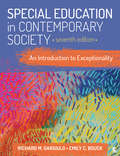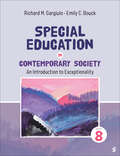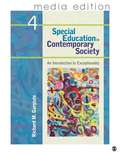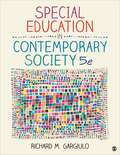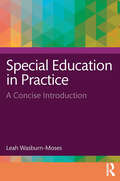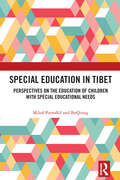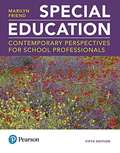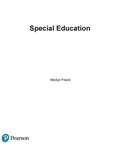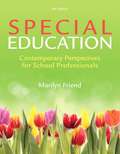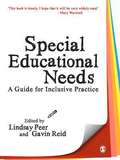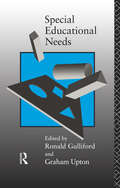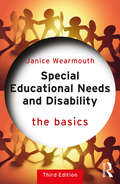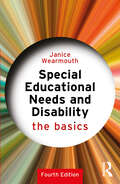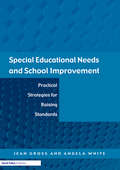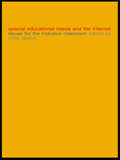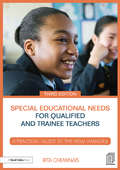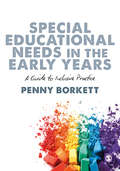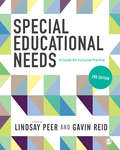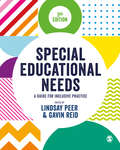- Table View
- List View
Special Education in Contemporary Society: An Introduction to Exceptionality
by Richard M. Gargiulo Emily C. BouckSpecial Education in Contemporary Society: An Introduction to Exceptionality offers a comprehensive, engaging, and readable introduction to the dynamic field of special education. Grounded in research and updated to reflect the most current thinking and standards of the field, this book provides students with the knowledge, skills, attitudes, and beliefs that are crucial to constructing learning environments that allow all students to reach their full potential. Authors Richard M. Gargiulo and Emily C. Bouck encourage a deep awareness and understanding of the "human" side of special education, providing students with a look into the lives of exceptional students and their families, as well as the teachers that work with exceptional persons throughout their lives. The Seventh Edition maintains the broad context and research focus for which the book is known while expanding on current trends and contemporary issues to better serve both pre-service and in-service teachers of exceptional individuals. This title is accompanied by a complete teaching and learning package.
Special Education in Contemporary Society: An Introduction to Exceptionality
by Richard M. Gargiulo Emily C. BouckSpecial Education in Contemporary Society: An Introduction to Exceptionality offers a comprehensive, engaging, and readable introduction to the dynamic field of special education. Grounded in the latest research, it reflects current educational standards and equips students with the knowledge, skills, attitudes, and beliefs needed to create inclusive learning environments that empower all students to reach their full potential. Authors Richard M. Gargiulo and Emily C. Bouck encourage a deep awareness and understanding of the "human" side of special education, offering insightful perspectives into the lives of exceptional students, their families, and the dedicated teachers who support them. The Eighth Edition of this text has been updated with new information on specific disabilities and challenges, issues of diversity and equity within special education, and the latest statistics and research that are a hallmark of this book.
Special Education in Contemporary Society: An Introduction to Exceptionality
by Richard M. Gargiulo Emily C. BouckSpecial Education in Contemporary Society: An Introduction to Exceptionality offers a comprehensive, engaging, and readable introduction to the dynamic field of special education. Grounded in research and updated to reflect the most current thinking and standards of the field, this book provides students with the knowledge, skills, attitudes, and beliefs that are crucial to constructing learning environments that allow all students to reach their full potential. Authors Richard M. Gargiulo and Emily C. Bouck encourage a deep awareness and understanding of the "human" side of special education, providing students with a look into the lives of exceptional students and their families, as well as the teachers that work with exceptional persons throughout their lives. The Seventh Edition maintains the broad context and research focus for which the book is known while expanding on current trends and contemporary issues to better serve both pre-service and in-service teachers of exceptional individuals. This title is accompanied by a complete teaching and learning package.
Special Education in Contemporary Society: An Introduction to Exceptionality
by Richard M. Gargiulo Emily C. BouckSpecial Education in Contemporary Society: An Introduction to Exceptionality offers a comprehensive, engaging, and readable introduction to the dynamic field of special education. Grounded in the latest research, it reflects current educational standards and equips students with the knowledge, skills, attitudes, and beliefs needed to create inclusive learning environments that empower all students to reach their full potential. Authors Richard M. Gargiulo and Emily C. Bouck encourage a deep awareness and understanding of the "human" side of special education, offering insightful perspectives into the lives of exceptional students, their families, and the dedicated teachers who support them. The Eighth Edition of this text has been updated with new information on specific disabilities and challenges, issues of diversity and equity within special education, and the latest statistics and research that are a hallmark of this book.
Special Education in Contemporary Society: An Introduction to Exceptionality (4th Edition)
by Richard M. GargiuloSpecial Education in Contemporary Society is first and foremost a textbook about people - individuals, who in many ways are very similar to their peers without a disability. This book serves as a comprehensive introduction to the dynamic field of special education and the children and young adults who benefit from receiving a special education.
Special Education in Contemporary Society: An Introduction to Exceptionality (Fifth Edition)
by Richard M. GargiuloThe Fifth Edition of Richard Gargiulo's well-respected Special Education in Contemporary Society: An Introduction to Exceptionality offers a comprehensive, engaging, and easy-to-read introduction to special education. Grounded in research and updated to reflect the most current thinking and standards of the field, the book provides students with the skills and knowledge to become successful teachers. Gargiulo's text encourages a deep awareness and understanding of the human side of special education. The book provides students a rare glimpse into the lives of exceptional students and their families, as well as the teachers that work with exceptional persons throughout their lives.
Special Education in Practice: A Concise Introduction
by Leah Wasburn-MosesThis concise yet comprehensive text offers an introduction to special education practice. It covers the basics in the field—including key definitions, history, and policy—and focuses on evidence-based practices in teaching, strategies for inclusive schools and classrooms, and contemporary issues affecting at-risk students more broadly. The book consists of six chapters designed to fit within various models of practice-based preparation and invites deliberate connections between the ideas it presents, and the active classroom practice it encourages. Each chapter features suggested collaboration and practice activities, and inquiry activities presented in the last chapter align with the 22 High Leverage Practices (HLPs) identified by leading researchers in the field. Special Education in Practice is an ideal text for teacher candidates in any licensure or teacher preparation program working within a practice-based setting.
Special Education in Tibet: Perspectives on the Education of Children with Special Educational Needs
by Miloň Potměšil Bu QiongThis book analyses the value orientation system of education in Tibet and examines the special education interventions aimed at children with disabilities in the region. The authors draw on their interviews with students, parents, and teachers to shed light on how education is viewed by the general population in Tibet. The book looks at themes such as traditional Tibetan education, the ways in which value orientation affects the development of disabled children, the role of special education interventions in building self-esteem and confidence, and the importance of developing pedagogical care and special schools in Tibet. It also reviews China’s existing legal provisions and policies dedicated to persons with disabilities in comparison with Tibet. Finally, it emphasizes the role of practicing social acceptance for children with special educational needs and recommends developing special education interventions based on the cultural foundation and real social conditions of the ethnic group. Based on in-depth qualitative and quantitative research, this book will be of interest to teachers, students, and researchers of education, special education, curriculum studies, sociology, anthropology, disability studies, minority studies and cultural studies. It will also be useful for educationalists, special education institutions, policymakers, social activists, and NGOs.
Special Education: Case by Case (3rd edition)
by Gwen Williams Conn Thomas Janice Seabrooks Len RobersonSpecial Education: Case by Case will help you develop your abilities as a teacher of students with disabilities by presenting many of the challenging situations you will find in your own classroom. Through these case studies, you will hone your skills as a teacher who puts students first and plans for their unique learning needs.
Special Education: Contemporary Perspectives For School Professionals
by Marilyn FriendReal teachers, real families and students, and real classrooms bring the field of Special Education to life. Special Education: Contemporary Perspectives for School Professionals, Fifth Edition, provides a multi-dimensional view of the field of special education. The most current information and research available provides structure and predictability for novices to the field of special education in today’s educational world. Because special education is made up of real children and real professionals, the author helps to put a “face” on the field to enliven and authenticate the information. Each chapter features stories of individuals with disabilities from the parents of children with disabilities and from professionals who work in the field. Readers of this truly exceptional text will come away with the best understanding of the expectations for educators and students, and learn how critical concepts translate into educational practices.
Special Education: Contemporary Perspectives For School Professionals
by Marilyn Penovich FriendSpecial Education Contemporary Perspectives for School Professionals 5th Edition
Special Education: Contemporary Perspectives for School Professionals 4th Revised Edition
by Marilyn D. FriendInformed by her years of experience working with students with disabilities and their teachers, this trusted author combines research-informed concepts and skills with practical information for educators working in this challenging age of high standards and accountability, curriculum access, inclusive practices, professional collaboration, student diversity, and legislative change.
Special Education: Rights and Responsibilities
by Community Alliance for Special Education Protection AdvocacyThis manual includes all aspects of the Individuals with Disabilities Education Act (IDEA). It also includes laws specific to California (e.g. Larry P.). It is a practical guide for anyone dealing with the Special Education process.
Special Educational Needs
by Gavin Reid Lindsay Peer'This book is timely. I hope that it will be very widely read' - Mary Warnock With a Foreword from Baroness Mary Warnock, this book provides a comprehensive overview of the field of special educational needs (SEN). It contains chapters written by a range of experts on different aspects of SEN, and is full of practical suggestions for how to achieve effective, inclusive practice. Various research perspectives are considered, the value of labels is examined and the need to recognize the overlapping characteristics between different syndromes is highlighted. Chapters focus on translating theory into classroom practice, and include case studies covering the Birth to 19 age range. There is coverage of: SEN and the state of research SEN and legal issues Parents' perspectives Speech and language difficulties Dyspraxia and occupational therapy Dyslexia and dyscalculia Auditory Processing Disorder Behavioural Optometry Attention Deficit Hyperactivity Disorder (ADHD) Asperger's Syndrome and Autistic Spectrum Disorder Tourette's Syndrome. Ideal for those undertaking teacher education courses, as well as experienced teachers, therapists and policy makers, this book is a guide to understanding and supporting learners with additional needs.
Special Educational Needs
by Graham Upton Ronald GullifordThe contributors focus on particular areas of special educational need, arguing that effective educational provision can be enhanced with reference to the particular problems experienced by children. Set in the context of a generic understanding of special education, this timely book addresses commonly-raised questions: what is the condition and how can I recognise it? why does it occur? what sort of educational, personal, and social consequences are there associated with it? are there any specialist skills and resources which I should know about? what are the implications for educational provision, teacher support, curricular access, assessment and classroom management? This popular book has been fully revised to provide a comprehensive overview of special needs provision. A such it is the key text on special needs in the '90s.
Special Educational Needs and Disability: A Critical Introduction (The Basics)
by Janice WearmouthSpecial Educational Needs and Disability: The Basics provides an engaging and comprehensive overview of special educational, and additional support, needs in education contexts in the UK. The third edition of this bestselling publication covers the historical development of special provision and national policy-making, and summarises current and proposed legislation and statutory guidance across England, Scotland, Northern Ireland and Wales, examining the fundamental principles of the field from policy to practice. Additional focus is given to recent legislation in England extending the age range of young people identified as experiencing difficulties from birth to 25 years, and the implications this has for practice. Fully updated to incorporate recent research evidence, this indispensable book covers essential features of policy and practice that teachers need to consider in and outside of the classroom, including: the identification and assessment of young people’s special or additional learning and behaviour needs, and/or disabilities approaches to planning in order to meet special or additional learning needs of children and young people ways to address barriers to learning and behaviour associated with a variety of difficulties statutory guidance outlined in the Codes of Practice in England (DfE, 2015), Scotland (2010), Wales (2004) and Northern Ireland (1998) special educational, or additional support, needs provision and the wider children’s workforce implications of disability legislation across the UK This is an ideal starting point for all those with questions about what constitutes special educational, or additional support, needs and disability and how to support those children and young people who experience such needs. It is essential reading for trainee and practising teachers, policy-makers and all those working with young people and their families.
Special Educational Needs and Disability: The Basics (The Basics)
by Janice WearmouthSpecial Educational Needs and Disability provides a clear, coherent overview of the historical development of the field of special educational, or additional learning or support needs and disability, and discusses important past and current social and political contexts in which this took place, as well as changes in the law across time. It offers broad coverage of a range of needs and disabilities, and how to effectively identify and support those young people who experience such needs. This revised fourth edition covers recent legislative changes across the UK, an expanded discussion of key areas such as social, emotional, and mental health, a new chapter on literacy difficulties, and further fair, balanced, and open discussion of up-to-date evidence that indicates how young people who experience barriers to their learning are affected by factors associated with such marketisation, for example competition between schools and the academies programme. Special Educational Needs and Disability serves as essential reading for trainee and practising teachers, members of governing boards in schools and colleges, policymakers, and all those working directly with learners and their families.
Special Educational Needs and School Improvement: Practical Strategies for Raising Standards
by Jean Gross Angela WhiteProviding a practical guide to strategic management in the field of special educational needs, this text gives the reader a framework for raising achievement throughout the school.
Special Educational Needs and the Internet: Issues for the Inclusive Classroom
by Chris AbbottWith Internet access for every school now a reality, teachers are beginning to explore the use of the Internet in the education of children with special needs. This book describes its benefits for children across the spectrum of special educational needs, from those with physical disabilities or sensory impairment to those with learning or social difficulties.With contributions from leading practitioners in the field, this book addresses the huge range of possibilities the Internet and associated technology offer for these pupils. Combining current theory and debate with practical guidance and inspiring case studies, this book considers:* how the Internet can be used to gather and publish information* how to communicate effectively through technology* policy and management issues for schools* the continuing challenges for access and inclusion.This book will be of interest to all teachers involved in special education needs, in both mainstream and special schools.
Special Educational Needs for Qualified and Trainee Teachers: A practical guide to the new changes
by Rita CheminaisThis completely revised and updated edition, previously published as Special Educational Needs for NQTs and TAs, addresses the latest Teachers’ Standards, and their application in meeting the most recent developments and changes in the special educational needs system and the new SEN Code of Practice. Essential reading and an invaluable guide for all qualified, newly qualified and trainee teachers, this highly practical text relates to those accessing SEN training via teaching school alliances, as well as Higher Education. Full of tips and strategies on how to meet the needs of a diversity of children and young people with special educational needs, in a range of educational settings, chapters cover: the latest Teachers’ Standards aligned to the most recent SEND changes the revised SEN Code of Practice, the Children and Families Act, and the Equality Act and its related Duties teaching schools, specialist leaders of education in SEN, and new training models for building teacher capacity in SEN how to meet the latest OFSTED inspection requirements for SEND what works best in the effective teaching of pupils with SEN and those eligible for the pupil premium Featuring useful checklists, templates and photocopiable, downloadable resources to support professional development in SEN, this practical resource contains a wealth of valuable advice, in addition to signposting to further information. This no-nonsense, down-to-earth authoritative text will provide essential reading for all experienced qualified, newly qualified and trainee teachers, as well as to those delivering SEND training in Higher Education, local authorities, and in teaching schools and their alliances.
Special Educational Needs in the Early Years: A Guide to Inclusive Practice
by Penny BorkettThis book unpacks the vital elements of SEN in the Early Years through the lens of inclusion. Using a comprehensive blend of theory, policy and practice it: - Covers the development of legislation and policy relating to SEND - Includes a wide-range of recommended readings - Encourages reflection to aid independent study - Provides case studies linking theory to practice Written in an accessible style, this book empowers you to not only understand the impact of policy on practice, but to question it.
Special Educational Needs in the Early Years: A Guide to Inclusive Practice
by Penny BorkettThis book unpacks the vital elements of SEN in the Early Years through the lens of inclusion. Using a comprehensive blend of theory, policy and practice it: - Covers the development of legislation and policy relating to SEND - Includes a wide-range of recommended readings - Encourages reflection to aid independent study - Provides case studies linking theory to practice Written in an accessible style, this book empowers you to not only understand the impact of policy on practice, but to question it.
Special Educational Needs: A Guide for Inclusive Practice
by Gavin Reid Lindsay PeerCovering contemporary policy issues, perspectives from practice and a range of common syndromes and barriers Special Educational Needs presents a wealth of information and guidance for students and professionals on how to achieve effective, inclusive practice. Second edition features include: · fully revised annotated further readings and links to useful websites; · a new chapter on Autism and Applied Behaviour Analysis (ABA) · a new chapter on Down Syndrome · updated reference to legislation, including the SEND Code of Practice (2014) · updated case studies covering 0-18 age range This comprehensive course text is ideal for students, teachers, practitioners and specialists, and provides a solid foundation for understanding and supporting learners with additional needs.
Special Educational Needs: A Guide for Inclusive Practice
by Gavin Reid Lindsay PeerCovering contemporary policy issues, perspectives from practice and a range of common syndromes and barriers Special Educational Needs presents a wealth of information and guidance for students and professionals on how to achieve effective, inclusive practice. Second edition features include: · fully revised annotated further readings and links to useful websites; · a new chapter on Autism and Applied Behaviour Analysis (ABA) · a new chapter on Down Syndrome · updated reference to legislation, including the SEND Code of Practice (2014) · updated case studies covering 0-18 age range This comprehensive course text is ideal for students, teachers, practitioners and specialists, and provides a solid foundation for understanding and supporting learners with additional needs.
Special Educational Needs: A Guide for Inclusive Practice
by Gavin Reid Lindsay PeerThis guide to inclusive practice covers contemporary policy issues, perspectives from practice and specialist guidance from across a wide range of common syndromes. Bringing together the important combination of theory, knowledge and practice, each chapter is written by experts from fields within Special and Additional Educational Needs. This third edition includes new chapters on: - The current context of SEN current context: in research and practice - Speech, language and communication - The role and use of technology in supporting learners with SEND - Pathological/Extreme Demand Avoidance (PDA/EDA) - Working together - Children and Young People’s Perspectives Providing a solid foundation for understanding and supporting learners with additional needs, this comprehensive text is ideal whether you are a student, teacher or education practitioner.
